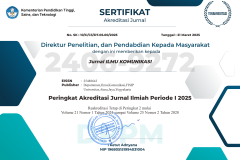The Identity of Garut Transgenders in Social Media
DOI:
https://doi.org/10.24002/jik.v20i2.5586Keywords:
Garut, social media, Sundanese culture, transgenderAbstract
The background of this research is the use of social media by transgenders in the Garut Regency, although the transgender issue is contradictory to Indonesian values. This qualitative research uses rational choice theory to analyze social media usage as an identity for transgenders in the Garut Regency. The data are collected through in-depth interviews, observation, and literature study. The results show that transgenders use social media as an associative interaction. It shows their identity by 'behaving gender' and expressing the 'sense of we' as Sundanese women.
References
Aguiar, F., & de Francisco, A. (2008). Can Rational Choice Cope with Identity? Andrés de Francisco.
Andreassen, C. S., Pallesen, S., & Griffiths, M. D. (2017). The Relationship Between Addictive Use of Social Media, Narcissism, and Self-esteem: Findings from a Large National Survey. Addictive Behaviors, 64, 287–293. https://doi.org/10.1016/j.addbeh.2016.03.006
Barmawi, B., & Silmi, M. (2016). Identifikasi Penyebab Transgender pada Waria di Banda Aceh. Jurnal Psikoislamedia, 1(2), 372-384.
Cannon, Y., Speedlin, S., Avera, J., Robertson, D., Ingram, M., & Prado, A. (2017). Transition, Connection, Disconnection, and Social Media: Examining the Digital Lived Experiences of Transgender Individuals. Journal of LGBT Issues in Counseling, 11(2), 68–87. https://doi.org/10.1080/15538605.2017.1310006
Gündüz, U. (2017). The Effect of Social Media on Identity Construction. Mediterranean Journal of Social Sciences, 8(5), 85–92. https://doi.org/10.1515/mjss-2017-0026
Haimson, O. L. (2019). Mapping gender transition sentiment patterns via social media data: Toward decreasing transgender mental health disparities. Journal of the American Medical Informatics Association, 26(8–9), 749–758. https://doi.org/10.1093/jamia/ocz056
Hughto, J. M. W., Reisner, S. L., & Pachankis, J. E. (2015). Transgender stigma and health: A critical review of stigma determinants, mechanisms, and interventions. In Social Science and Medicine (Vol. 147, pp. 222–231). Elsevier Ltd. https://doi.org/10.1016/j.socscimed.2015.11.010
Khasan, M., & Sujoko, S. (2018). Perilaku Koping Waria (Studi Fenomenologi Kasus Diskriminasi Waria Di Surakarta) (Vol. 7).
Looy, H., & Bouma III, H. (2005). The Nature of Gender: Gender Identity in Persons Who Are Intersexed or Transgendered. Journal of Psychology and Theology, Vol 33(3), 166–178.
Pazolt, D. (2020). Quality of Life Among Transgender and Gender Non-Conforming. https://vc.bridgew.edu/grad_rev/vol5/iss1/13
Raturahmi, L. (2018). Perilaku Penggunaan Media Massa Pada Masyarakat Perdesaan. Agustus, 213–224.
Sato, Y. (2013). Rational choice theory. Sociopedia. https://doi.org/10.1177/205684601372
Sumerau, J. E., Mathers, L. A. B., & Cragun, R. T. (2018). Incorporating Transgender Experience Toward a More Inclusive Gender Lens in the Sociology of Religion. In Sociology of Religion: A Quarterly Review (Vol. 79, Issue 4, pp. 425–448). Association for the Sociology of Religion. https://doi.org/10.1093/socrel/sry001
van Dijck, J., & Poell, T. (2013). Understanding Social Media Logic. Media and Communication, 1(1), 2–14. https://doi.org/10.12924/mac2013.01010002
West, C., & Zimmerman, D. H. (1987). Doing Gender. Gender and Society. Gender and Society, 1(2), 125–151.
Downloads
Published
How to Cite
Issue
Section
License

This work is licensed under a Creative Commons Attribution 4.0 International License.
Jurnal ILMU KOMUNIKASI is an academic journal. As such, it is dedicated to the open exchange of information. For this reason, JIK is freely available to individuals and institutions. Authors who publish in Jurnal ILMU KOMUNIKASI will release their articles under the Creative Commons Attribution (BY) License. This license allows anyone to copy and redistribute the article in any medium or format as well as remix, transform, and build upon the material for any purpose, even commercially as long as they credit the authors for the original creation. For details of the rights authors grants users of their work, see the "human-readable summary" of the license, with a link to the full license. (Note that "you" refers to a user, not an author, in the summary)
 This work is licensed under a Creative Commons Attribution 4.0 International License.
This work is licensed under a Creative Commons Attribution 4.0 International License.














